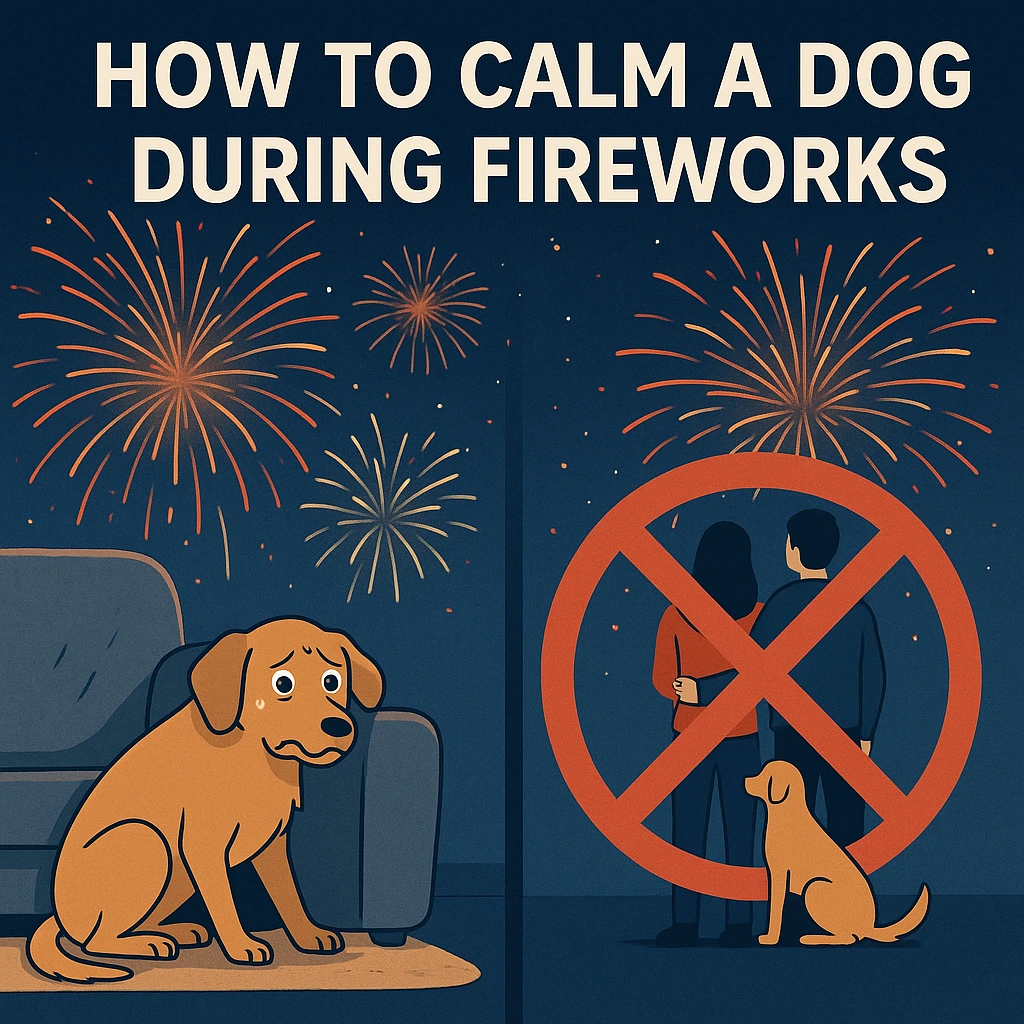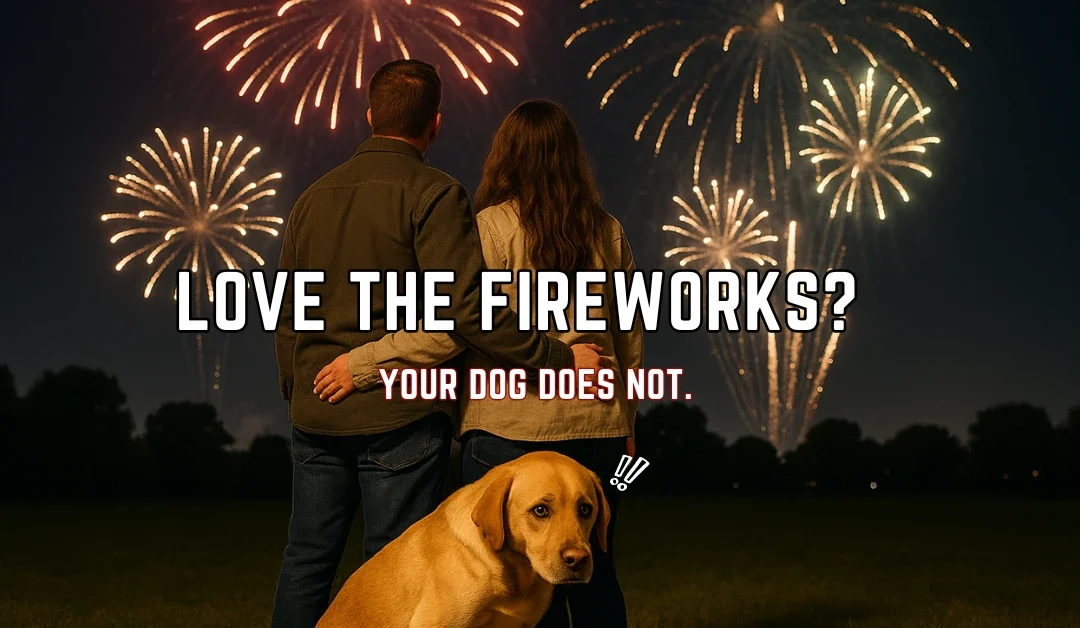Have you ever watched your dog tremble, pant, or bolt under the couch when fireworks start exploding outside?
You’re not alone. Fireworks might be fun for us—but to your dog, they’re a terrifying, unpredictable war zone. And every year, around holidays like Canada Day or the Fourth of July, shelters fill with dogs who’ve panicked and run. It’s heartbreaking—and preventable.
In this blog, we’ll break down exactly how to calm a dog during fireworks in a way that’s straightforward, actionable, and rooted in real-life training. I’ll also show you what not to do—starting with that innocent idea of bringing your dog to a fireworks show. (Spoiler alert: don’t.)
What We’ll Cover:
- Why dogs fear fireworks (and why that fear doesn’t just go away)
- What not to do (with visuals you won’t forget)
- How to prep your dog ahead of time
- Last-minute calming strategies that actually help
- Tools and techniques I use with clients
- Real talk: when you need professional help
Why Fireworks Freak Dogs Out
Let’s start with the basics. Dogs have incredible hearing—far more sensitive than ours. A firework might sound like a pop to you, but to your dog? It’s a full-on sonic boom.
It’s not just the volume. It’s the unpredictability. The lack of control. The flashing lights. The strange smells. It’s everything at once, and it triggers the fight, flight, or freeze response.
Some dogs learn to cope—but most just get better at hiding their stress. That’s not the same as being calm.
This Isn’t About Toughening Up
You can’t “train” fear out of a dog by ignoring it or exposing them to more of it. Fear doesn’t respond to logic—it responds to safety. Your dog isn’t being dramatic. They’re having a real emotional response to what their brain believes is danger.
That’s why you need a plan.

What NOT to Do During Fireworks
Before we get to the solutions, let’s start with a visual reminder of what to avoid:
❌ Standing Outside Watching Fireworks With Your Dog
Don’t bring your dog outside to “help them get used to it.” This backfires. Dogs learn by association. If they associate fireworks with panic—and you’re standing there ignoring that panic—you’re breaking trust. Period.
❌ Coddling Every Whimper
Here’s where people get confused. You absolutely want to comfort your dog—but not reinforce the panic. That means calm presence, not frantic energy. Sit near them. Speak softly. Breathe slowly. Act like a calm anchor.
❌ Leaving Them Alone Without Prep
If you know fireworks are coming, don’t wing it. Don’t assume your dog will be fine this time. Without prep, they might bolt through a screen, chew through drywall, or get hurt trying to escape.
How to Prepare Your Dog Ahead of Time
This is where we turn the tables. The more you prepare in advance, the better chance your dog has of staying calm and safe.
1. Create a Firework-Safe Zone
Pick a spot in your home that your dog already feels good about—maybe their crate, a quiet bathroom, or your closet. Add blankets, a frozen stuffed Kong, soft music, and dim lights. Bonus if it’s a space you’ve conditioned as a calm zone using scent or calming routines.
2. Use Desensitization Training (Start Early!)
Play low-volume firework sounds on YouTube or Spotify. Pair it with treats and play. Gradually increase the volume over weeks—not days. This builds a new association: fireworks = fun things happen.
3. Practice Calm Check-Ins
In the days before fireworks, practice calmly checking in with your dog every time a loud noise happens—like a door slamming. Reward them for staying calm. If they react, don’t panic—redirect to something easy, like a sit or a hand target.
Last-Minute Calming Strategies for Fireworks Night
Didn’t prepare in advance? Don’t worry. You’ve still got options.
1. Keep Them Inside (Always)
Don’t risk letting your dog out in the yard when fireworks are going off. Even a fenced yard isn’t foolproof when panic kicks in.
2. Try White Noise and Music
Classical music or brown noise can mask the sound of fireworks. Choose something calming and familiar. Turn it on before the fireworks start.
3. Use Calming Aids (With Vet Approval)
Products like Adaptil (a calming pheromone diffuser), L-theanine chews, or vet-approved anxiety meds can make a big difference—but always check with your vet first.
4. Be Their Anchor
This part’s on you. You set the emotional tone. If you’re tense, your dog feels it. If you’re calm and present, they can settle more easily. Sit near them. Don’t force eye contact. Just be there.
Tools I Use with Clients for Fireworks Prep
As a professional trainer, here are tools I recommend (and use myself):
✅ Snuffle Mats & Lick Mats
Let them work out their stress through sniffing and licking. These natural behaviors reduce anxiety.
✅ Calming Collars or Wraps (Like ThunderShirt)
Some dogs respond well to compression gear. Try it on before fireworks night so they associate it with calm, not chaos.
✅ Frozen Enrichment
Stuff a Kong or Toppl with peanut butter, freeze it, and give it just as the noise starts. Keeps their mouth busy and brain engaged.
✅ The “Sit-on-the-Dog” Exercise
If your dog is trained in this, use it. (If not, this is a great thing to start learning for next time.) It’s a way to encourage calm by sitting on the leash while staying disengaged.
When You Need More Than DIY
Sometimes fear runs deep. If your dog panics even with prep and support, don’t feel bad. That just means you need professional help.
Talk to your vet about anxiety medication. Reach out to a reputable trainer who uses proven methods. Firework phobia isn’t something you ignore. It’s something you support your dog through.
Need guidance or personalized help? Book a 1:1 Zoom training session with me here. We’ll create a custom plan to help your dog stay safe and calm—no matter what’s going on outside.
Your Dog Is Counting on You
Here’s the truth: your dog doesn’t need you to fix the fireworks. They need you to keep them safe.
So make the safe zone. Do the prep. Skip the fireworks outing. Be the calm in their storm.
And next year? Start early. Help them build a different story about those big, booming lights.
Because when you know how to calm a dog during fireworks, you’re not just preventing panic—you’re building trust.
References:
- American Kennel Club (AKC). (n.d.). How to Keep Your Dog Calm During Fireworks. Retrieved from https://www.akc.org/expert-advice/training/how-to-keep-your-dog-calm-during-fireworks/
- Blue Cross UK. (n.d.). Dogs and Fireworks. Retrieved from https://www.bluecross.org.uk/advice/dog/behaviour-and-training/dogs-and-fireworks
- RSPCA. (n.d.). Fireworks Advice for Pet Owners. Retrieved from https://www.rspca.org.uk/adviceandwelfare/pets/general/fireworks
- Adaptil UK. (n.d.). Dogs and Fireworks Stress. Retrieved from https://www.adaptil.co.uk/pages/dogs-and-fireworks-stress
Enjoyed this read? For more no-nonsense insights on dog training and behavior, check out my earlier blogs:
- Crate Training a Puppy: What to Do When Your Puppy Hates the Crate
- DIY Solution: Flea and Tick Prevention for Dogs
- Dog Dental Care: Why It’s More Important Than You Think
There’s always something new to learn, even if it’s just a different perspective on the everyday challenges we face. Happy reading!
Contact Us to get frequent updates, free downloadables, and dog training tips! Click here to subscribe.
Let’s stay connected:

